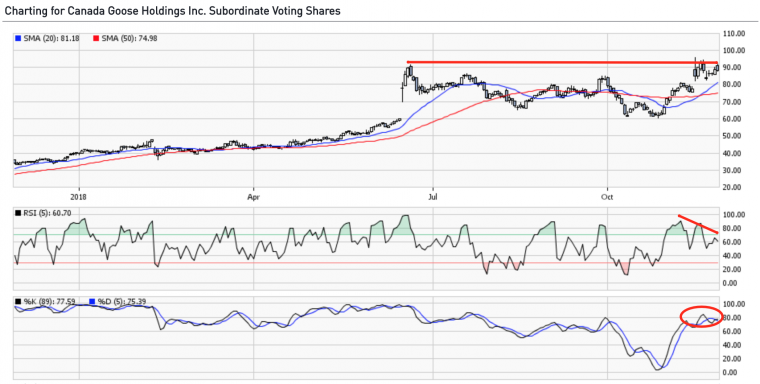Selling call options at resistance

As we can see from the following chart, the share price of Canada Goose Holdings Inc. (GOOS) just hit the $90 resistance level after a major 50% rally in just one month. We can also see that the RSI (5) has fallen, while the stochastic indicator shows it is in overbought territory (%K [89]). This situation is an indication of a temporary halt in the stock’s rise, or even a more or less pronounced decline.
Daily graph as at November 26, 2018 ($87.98)

An investor who wants to profit from time decay during this lull, while also gaining useful protection, could sell a call option for each slice of 100 stocks held. With the stock price at $87.98, we will calculate the value of three call options expiring on January 18, 2019 with strike prices of $86, $88 and $90.
Comparison of profit and loss profiles

The table above compares the profit and loss profiles for a strategy that sells covered calls based on different strike prices; $86, $88 and $90.
Call options with a strike price of $86 allow to collect a premium of $8.15 per share, or $815 per contract. This in-the-money option, which has an intrinsic value of $1.98 ($87.98 – $86) and a time value of $6.17 ($8.15 – $1.98), provides a protection of 9.26% against a stock price decline. The maximum profit of $6.17 per share (strike price of $88 – stock price of $87.98 + premium received of $8.15) or 7.73% (53.23% annualized) will be achieved if the stock price is higher than the strike price of $88 when the option expires on January 18. The static profit, i.e., the profit generated if the stock price holds steady until expiry, is the same as the maximum profit.
Call options with a strike price of $88 allow to collect a premium of $7.50 per share, or $750 per contract. This at-the-money (actually, slightly out-of-the-money) call option, which has no intrinsic value and a time value of $7.50, provides a protection of 8.52% against a stock price decline. The maximum profit of $7.52 per share (strike price of $88 – stock price of $87.98 + premium received of $7.50) or 9.34% (64.35% annualized) will be achieved if the stock price is higher than the strike price of $88 when the option expires on January 18. The static profit, i.e., the profit generated if the stock price holds steady until expiry, is $7.50 per share (the time value of the call options) and represents a return of 9.32% (64.18% annualized).
Call options with a strike price of $90 allow to collect a premium of $6.40 per share, or $640 per contract. This out-of-the-money call option, which has no intrinsic value and a time value of $6.40, provides a protection of 7.27% against a stock price decline. The maximum profit of $8.42 per share (strike price of $90 – stock price of $87.98 + premium received of $6.40) or 10.32% (71.08% annualized) will be achieved if the stock price is higher than the strike price of $90 when the option expires on January 18. The static profit, i.e., the profit generated if the stock price holds steady until expiry, is $6.40 per share (the time value of the call options) and represents a return of 7.85% (54.03% annualized).
When choosing the strike price, the investor must make a trade-off between the maximum return and protection in the event of a decline.
Intervention
If the stock price falls or remains stable, action may be taken if we can purchase call options sold for between 10% and 20% of the initial price. In such a case, we should conduct an analysis to confirm whether it is still a good idea to keep selling call options to hedge against risk. If the price rises higher than the strike price, the call options will have to be re-purchased at a profit or a loss, depending on the situation, to prevent them from being assigned and having to sell the underlying stocks. If not, the call options will be exercised by the holder and we will be forced to sell the stocks at the chosen strike price.
Good luck with your trading, and have a good week!
The strategies presented in this blog are for information and training purposes only, and should not be interpreted as recommendations to buy or sell any security. As always, you should ensure that you are comfortable with the proposed scenarios and ready to assume all the risks before implementing an option strategy.
President
Monetis Financial Corporation
Martin Noël earned an MBA in Financial Services from UQÀM in 2003. That same year, he was awarded the Fellow of the Institute of Canadian Bankers and a Silver Medal for his remarkable efforts in the Professional Banking Program. Martin began his career in the derivatives field in 1983 as an options market maker for options, on the floor at the Montréal Exchange and for various brokerage firms. He later worked as an options specialist and then went on to become an independent trader. In 1996, Mr. Noël joined the Montréal Exchange as the options market manager, a role that saw him contributing to the development of the Canadian options market. In 2001, he helped found the Montréal Exchange’s Derivatives Institute, where he acted as an educational advisor. Since 2005, Martin has been an instructor at UQÀM, teaching a graduate course on derivatives. Since May 2009, he has dedicated himself full-time to his position as the president of CORPORATION FINANCIÈRE MONÉTIS, a professional trading and financial communications firm. Martin regularly assists with issues related to options at the Montréal Exchange.
The information provided on this website, including financial and economic data, quotes and any analysis or interpretation thereof, is provided solely for information purposes and shall not be construed in any jurisdiction as providing any advice or recommendation with respect to the purchase or sale of any derivative instrument, underlying security or any other financial instrument or as providing legal, accounting, tax, financial or investment advice. Bourse de Montréal Inc. recommends that you consult your own advisors in accordance with your needs before making decision to take into account your particular investment objectives, financial situation and individual needs.
All references on this website to specifications, rules and obligations concerning a product are subject to the rules, policies and procedures of Bourse de Montréal Inc. and its clearinghouse, the Canadian Derivatives Clearing Corporation, which prevail over the content of this website. Although care has been taken in the preparation of the documents published on this website, Bourse de Montréal Inc. and/or its affiliates do not guarantee the accuracy or completeness of the information published on this website and reserve the right to amend or review, at any time and without prior notice, the content of these documents. Neither Bourse de Montréal Inc. nor any of its affiliates, directors, officers, employees or agents shall be liable for any damages, losses or costs incurred as a result of any errors or omissions on this website or of the use of or reliance upon any information appearing on this website.
BAX®, CADC®, CGB®, CGF®, CGZ®, LGB®, MX®, OBX®, OGB®, OIS-MX®, ONX®, SCF®, SXA®, SXB®, SXF®, SXH®, SXM®, SXO®, SXY®, and USX® are registered trademarks of the Bourse. OBW™, OBY™, OBZ™, SXK™, SXJ™, SXU™, SXV™, Montréal Exchange and the Montréal Exchange logo are trademarks of the Bourse. All other trademarks used are the property of their respective owners.
© 2024 Bourse de Montréal Inc. All Rights Reserved.
